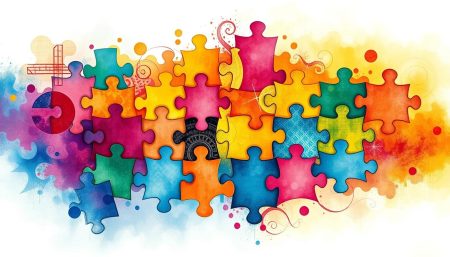Getting to know mild autism spectrum disorder is key to a more welcoming world. As we learn about this condition, we also push for more ASD awareness and better autism understanding. Even though mild autism is less obvious than severe forms, it’s just as important to understand and support.
Every person with autism faces their own set of challenges and strengths. This introduction is the start of exploring mild autism’s subtle details. By doing so, we can help individuals and their families more, making a world where everyone is valued and respected.
What is Mild Autism Spectrum Disorder?
Autism spectrum disorder (ASD) comes in many forms and severities. At the milder end, autism’s effects are often subtle. They can affect people in different ways than more severe forms.
The Spectrum Nature of Autism
The autism spectrum is wide and varied. It includes symptoms from mild to severe. Each person’s experience with autism is unique. This makes diagnosing and understanding ASD complex.
Clinical Definition of Mild ASD
The DSM-5 defines mild ASD by slight social communication issues. People with mild ASD may do well in school and social settings. But, they might struggle in more complex or unstructured situations.
Differences Between Mild and More Severe Forms of Autism
Looking at mild vs. severe autism shows big differences. Those with severe autism need a lot of help with daily tasks. But, people with mild autism need less help. They focus on overcoming specific social and communication hurdles.
Early Signs of Mild Autism in Children
Spotting early signs of mild autism in kids means knowing certain signs that show up early. The American Academy of Pediatrics says it’s key to watch for developmental milestones. They also warn about signs that might mean a child is on the autism spectrum.
Childhood ASD indicators include social and behavioral signs. Catching these signs early can help with early help. This can lead to better results. Here are some important early signs:
- Limited eye contact or trouble keeping eye contact
- Speech delay or no babbling by 12 months
- Little interest in making friends or playing games
- Prefer solo or repetitive play over interactive games
- Doesn’t respond to name by 12 months
- Resists cuddling or being held
Also, clinical child psychologists say to watch how a child interacts with their world. Not responding to words or focusing too much on certain things could be signs of early signs of mild autism.
| Age | Expected Milestone | ASD Indicator |
|---|---|---|
| 6 Months | Big smiles or joyful expressions | Infrequent smiling, limited mimicry of facial expressions |
| 9 Months | Sounds or babbling | Limited or no babbling |
| 12 Months | Using gestures such as pointing or waving | Rare use of gestures; may not point or wave back |
| 16 Months | Speaking single words | Minimal use of words or absence of spoken words |
| 24 Months | Two-word meaningful phrases (not including imitating or repeating) | Seldom combines words independently |
Watching closely and getting professional help is key if you see these signs. Early diagnosis and the right help can greatly improve a child’s development.
Characteristics of Mild Autism Spectrum Disorder
Mild Autism Spectrum Disorder (ASD) shows unique behaviors and ways of thinking and feeling. These traits affect how people act and interact with others every day.
Understanding Social Interaction Difficulties
Those with mild ASD face less obvious social deficits than others. They might find it hard to understand non-verbal signals, keep up in talks, and make friends. Social experts say these folks want to connect but find social rules too complex, leading to feelings of loneliness.
Cognitive Patterns in Mild ASD
Studies show that mild ASD folks have special ways of learning and solving problems. Their ability to adapt to new situations varies. This affects how they see and deal with the world, shaping how we teach and help them.
Sensory Sensitivity and Mild Autism
Sensory processing in ASD means some people are more or less sensitive to things around them. This can include being bothered by loud sounds, bright lights, or certain textures. It’s important to understand and meet these needs to make a supportive space for them.
Challenges Faced by Individuals with Mild Autism
People with mild autism face many daily challenges. These can make it hard to do well in school, social situations, and work. It’s important to find ways to manage mild autism to improve their lives and help them fit into society better.
Studies and interviews have shown some common problems. These include trouble with social interactions, being too sensitive to sounds and sights, and issues with planning and organization. These problems can make school and work harder.
| Challenge | Impact | Common Coping Strategies |
|---|---|---|
| Social Interaction | Difficulties in understanding social cues leading to social isolation. | Structured social skills training and peer-mediated approaches. |
| Sensory Sensitivity | Overwhelm in environments with excessive sensory stimuli. | Use of sensory-friendly tools and environments; personalized sensory diets. |
| Executive Functioning | Challenges with organization and time management impact academic and occupational success. | Cognitive behavioral techniques and visual schedules. |
Understanding and tackling these challenges is key for those with mild autism. It helps them manage their daily challenges better and join in more with society.
This part of our talk is very important. It shows how vital it is to have support that really helps. This support is essential for those with mild autism as they try to fit into society.
Interventions for Mild Autism
Helping those with mild autism needs a mix of special therapy, school changes, and tech. These steps help grow skills and improve talking and social skills. This makes life better for those with mild autism.
Behavioral Therapies and Support
Behavioral therapy is key for mild autism, backed by many studies. It uses methods like Applied Behavior Analysis (ABA) to focus on social and life skills. This therapy also helps reduce bad behaviors and encourages good ones, helping people grow over time.
Educational Interventions and Classroom Adaptations
Good education is vital for kids with mild autism. Plans that fit each child, like structured classrooms and visual aids, make learning better. Teachers, parents, and experts must work together to make learning spaces just right for each student.
Role of Technology in Managing Mild Autism
Technology has changed how people with mild autism learn and connect. Apps for talking and interactive tools that change with user input help a lot. They offer learning that fits each person and makes daily life easier.
| Intervention Type | Tools/Strategies | Impact |
|---|---|---|
| Behavioral Therapy | ABA, Positive Reinforcement | Improves communication, Reduces problematic behaviors |
| Educational Adaptations | Visual Schedules, Sensory-friendly classrooms | Enhances academic engagement and success |
| Technology | Communication apps, Interactive learning tools | Supports personalized learning, Aids in daily independence |
Mild Autism Spectrum Disorder in Adults
Understanding autism in adults is growing. Adults with mild autism can live fulfilling lives with the right support. They can stay independent and handle life’s challenges.
The Importance of Timely Diagnosis
An adult ASD diagnosis is key. It opens doors to special resources and help. It helps them understand themselves and get support from others.
Lifestyle and Independence
Independence is a big goal for adults with mild autism. Getting the right support helps them live better. It lets them work and live in ways that fit their needs.
Resources and Support for Adults
Adults with mild autism need good resources to manage life. Support groups, therapy, and special programs help a lot. They build a community that understands and supports them.
| Resource Type | Description | Benefits |
|---|---|---|
| Support Groups | Groups focusing on sharing experiences and strategies. | Enhances social skills, reduces isolation. |
| Employment Assistance | Programs to aid in finding and maintaining employment. | Improves financial independence and self-esteem. |
| Therapeutic Interventions | Professional therapy for emotional and behavioral management. | Helps manage symptoms, improves personal relationships. |
Mild Autism Spectrum Support Networks
When dealing with mild autism, ASD support communities are key. They offer families and those on the autism spectrum valuable resources and emotional support. These groups are places where people can share their experiences and learn from each other.
Support networks do more than just provide emotional support. They also help improve the lives of those with ASD. Studies show that being part of these groups can lead to better social skills and easier access to autism-related information.
Here’s a list of national and local groups from top ASD organizations. They offer specific support to those with mild autism and their families.
| National Organization | Services Offered | Contact Information |
|---|---|---|
| Autism Speaks | Resource guides, advocacy, research updates | info@autismspeaks.org |
| The Autism Society | Education programs, local chapters, online support | support@autismsociety.org |
| Autistic Self Advocacy Network | Leadership training, policy advocacy | info@autisticadvocacy.org |
| National Autism Association | Safety resources, parent training, financial aid | contactus@nationalautism.org |
Being part of ASD support communities offers more than just advice. It builds a network of people who support each other’s growth. This interaction helps break down myths about mild autism, leading to better understanding and acceptance.
How to Support Someone with Mild Autism
Supporting someone with mild autism needs careful thought and effective strategies. Creating a supportive environment, improving communication, and helping with social skills are key. Families and teachers can greatly enhance the life of those with mild autism by doing these things.
Creating an Inclusive Environment
Creating an inclusive space is vital for mild autism support. This means arranging rooms to avoid too much sensory input. It also means using tools that help with daily and learning tasks.
Things like visual schedules and quiet areas are important. They help make people feel safe and confident.
Communication Strategies for Mild Autism
Good communication is essential for mild autism support. Speech therapists suggest using simple, clear language and visual aids. This helps people understand better.
Using tools like communication devices can also help. It makes it easier for them to express themselves.
Encouraging Social Skills Through Play and Interaction
Play is key for developing social skills. Activities that encourage teamwork and taking turns are very helpful. Regular feedback and praise for good social behavior also play a big role.
Schools and community centers can help by using inclusive strategies. Here’s a table with some activities that help with social skills:
| Activity Type | Description | Benefits |
|---|---|---|
| Role-playing Games | Structured scenarios that engage multiple participants to simulate social interactions. | Improves verbal/non-verbal communication skills. |
| Team Sports | Activities that require cooperation and understanding among players. | Enhances teamwork and empathy. |
| Storytelling Groups | Groups that allow individuals to narrate stories while others listen and take turns. | Develops listening skills and perspective-taking. |
| Arts and Crafts | Projects that involve a creative collaboration between individuals. | Promotes fine motor skills and cooperation. |
Diagnosing Mild Autism Spectrum Disorder
Getting a mild ASD diagnosis involves detailed checks and rules from the American Psychiatric Association in the DSM-5. It’s key for parents, teachers, and doctors to know about autism assessment. This helps them support those with mild ASD well.
Doctors diagnose autism by watching how a person acts and by looking at their past. A full autism assessment needs many experts. They use tools and talk to families to get all the facts.
- Review of developmental history: includes family interviews focusing on early childhood development
- Behavioral observations: structured and naturalistic settings to assess social interaction, communication skills, and repetitive behaviors
- Standardized testing: various tools to measure cognitive function, language skills, and motor coordination
They compare all the data to the DSM-5 rules. This makes sure the diagnosis is right and complete.
| Process | Key Professionals Involved | Tools Used |
|---|---|---|
| Initial evaluation | Pediatricians, Psychologists | Developmental history interviews, Autism Diagnostic Observation Schedule (ADOS) |
| Follow-up assessments | Neurologists, Specialist therapists | Standardized developmental tests, Behavioral assessments |
| Ongoing monitoring | Educational psychologists, Behavioral analysts | IEP reviews, Functional behavior assessments |
The quality of a mild ASD diagnosis depends on teamwork. Experts work together to really understand each person’s needs and challenges.
In short, the autism assessment must be detailed and change as needed. It’s important to keep checking and updating to meet each person’s evolving needs.
Coping Strategies for Mild Autism Spectrum Disorder
Families and individuals with mild autism often look for ways to make daily life easier. They find that routines, sensory-friendly spaces, and managing stress are key. This section will look at practical ways to tackle these challenges.
Developing Routine and Structure
Experts say a stable routine helps a lot with coping with mild autism. Knowing what to expect each day lowers anxiety. It makes it simpler for people to get through their day.
Addressing Sensory Issues
For those who are sensitive to their surroundings, sensory integration strategies are vital. Occupational therapists suggest creating spaces that either lessen sensory overload or provide calming inputs. This helps meet the individual’s needs.
Stress Management Techniques
- Regular physical activity
- Structured relaxation techniques such as mindfulness or yoga
- Scheduled downtime to prevent overwhelm
Stress reduction methods backed by clinical psychology are helpful. They work best when they match the person’s preferences and how they cope.

| Strategy | Benefits | Implementation Tips |
|---|---|---|
| Daily routines | Reduces anxiety, increases predictability | Keep schedules visual and consistent. |
| Sensory adjustments | Decreases sensory overload, enhances focus | Use of noise-canceling headphones, soft lighting, and personal comfort objects |
| Stress management | Improves overall well-being, decreases outbursts | Involve in activities that promote calmness and emotional regulation |
Using these strategies can help not just cope with mild autism but also thrive. It starts with knowing what each person needs. Then, with the right support, families can build a safe and supportive environment for growth and comfort.
Understanding and Managing Emotional Responses in Mild Autism
Managing emotions in ASD can be tough for those with autism and their families. It’s key to understand the unique ways people with autism show and handle emotions. By looking into new research and therapy methods, we can find ways to help.
Understanding autism emotions is vital for creating effective help plans. Mental health experts have developed therapies to improve how people with autism express and manage their feelings. This can greatly enhance their life quality.
- Individualized therapy sessions that address specific emotional regulation challenges.
- Integration of routine activities that promote calm and structured environments.
- Family therapy sessions that improve communication and understanding among family members.
Exploring the specific therapies used can help us see how they help manage autism emotions:
| Technique | Description | Benefits |
|---|---|---|
| Cognitive Behavioral Therapy (CBT) | Targets the thought processes and behaviors that lead to intense emotional responses. | Improves emotional awareness and self-regulation. |
| Social Skills Training | Focuses on improving interpersonal skills in a social context. | Enhances social communication, leading to better emotional understanding. |
| Mindfulness and Relaxation Techniques | Techniques such as deep breathing and meditation geared towards reducing anxiety and stress. | Helps in managing acute emotional responses by promoting calm. |
Symptoms of Mild Autism
Understanding mild autism spectrum disorder (ASD) symptoms is key for early help. This part talks about the signs of ASD, like behavioral and communicative ones. It helps caregivers and doctors spot and support those with mild autism.
Recognizing Behavioral Indicators of Mild Autism
ASD symptoms in mild cases can be hard to spot. They vary from person to person. Yet, some signs are common, like trouble with routine changes and strong reactions to sounds or sights.
People with mild autism might also like to be alone more. Paying attention to these signs can help manage the condition.
Communication Challenges and Abilities
Those with mild autism might find talking and understanding gestures hard. They might struggle to keep eye contact or use facial expressions right. But, they could be great at detailed talks or have a big vocabulary in their favorite topics.
Repetitive Behaviors as a Symptom of Mild Autism
Repeating actions or needing certain routines is a big sign of mild autism. These can be simple, like hand-flapping, or more complex, like daily routines. These habits help them feel secure and in control.
The Role of Diet and Nutrition in Managing Mild Autism
The field of nutrition plays a big role in treating Mild Autism Spectrum Disorder (ASD). It focuses on the importance of an autism diet and good nutrition. Studies show that what we eat can really affect ASD symptoms. We’ll look at how diet affects ASD and what dietitians suggest.
There are many ways to manage ASD nutritionally, based on research and experience. A special diet can help with behavior and improve health. It can also help with sleep, focus, and feeling well physically.
| Component | Benefits | Sources |
|---|---|---|
| Omega-3 Fatty Acids | Improves cognitive function and neurodevelopment. | Fish, seed oils, and nuts. |
| Gluten-Free and Casein-Free (GFCF) Diet | Known to reduce ASD symptoms like social withdrawal and repetitive behaviors. | Rice, soy, and corn products, fruits, and vegetables. |
| Probiotics | Enhances gut health, which is linked to improved mood and behavioral outcomes. | Yogurt, kefir, and fermented foods. |
Following a specific diet is key for these benefits. Dietitians who focus on nutritional management in ASD suggest regular checks. This helps make the diet better fit the person’s changing needs. It’s a way to make sure the diet works well for each person.
In short, knowing how an autism diet helps manage symptoms is important. It can improve life for those with ASD. By adding nutrition plans to treatment, we can offer better support. This helps people with ASD live better lives in the long run.
Mild Autism Treatment Options
Looking into effective treatments is key for better lives for those with mild autism. A mix of medication for ASD, holistic autism therapy, and a team effort often works best.
Medication and Mild Autism
Not all with mild ASD need medicine. But, some meds help with anxiety, depression, and being too active. It’s important to find the right medication for ASD under a doctor’s watchful eye.
Alternative Therapies for Mild ASD
For those not into meds, holistic autism therapy is a good choice. Music, occupational, and sensory integration therapies help a lot. They aim to boost social, communication, and motor skills in a caring way.
Importance of a Multi-Disciplinary Approach
Using many treatment views is best for a full care plan. This team includes psychologists, occupational therapists, and speech therapists, plus family. Together, they make a mild autism treatment plan that covers all bases.
| Treatment Type | Focus Area | Expected Outcome |
|---|---|---|
| Medication | Anxiety and Hyperactivity | Reduction in Overstimulation |
| Music Therapy | Social Skills | Increased Engagement and Interaction |
| Sensory Integration | Sensory Processing | Improved Daily Functioning |
Educational Considerations for Children with Mild Autism
Children with mild autism spectrum disorder (ASD) can do well in school with the right support. Tailored educational adaptations and effective learning strategies for mild autism make a big difference. These help students learn and succeed better.
Special education guidelines suggest making changes to help these kids. This includes creating structured learning spaces and classrooms that are friendly to senses. Teachers should use methods that fit each child’s learning pace and style.
- Visual aids and tools to enhance understanding and retention
- Behavioral cues to assist in the navigation of social interactions and transitions
- Technology devices that promote independent learning
It’s also important to create an environment that helps kids feel part of the group. This space should encourage communication and happiness.
| Grade Level | Adaptation | Impact |
|---|---|---|
| Elementary | Visual Schedules | Improves daily routine comprehension |
| Middle School | Peer Mentoring Programs | Enhances social skills and peer relationships |
| High School | Specialized Career Counseling | Prepares for post-school opportunities |
These educational adaptations help students with mild autism in many ways. They support not just their schoolwork but also their emotional and social growth. This prepares them for success in school and beyond.

The Importance of Advocacy for Mild Autism Spectrum Awareness
Advocacy for ASD is key in changing how people see and accept those with mild autism. It’s about more than just raising awareness. It’s about understanding and supporting each person with autism in their own way. Groups advocate for those with autism, sharing their challenges and strengths.
These groups work hard to clear up misconceptions and spread accurate information. They push for support that fits each person’s needs. This approach helps everyone understand and support individuals with autism better.
Studies show that advocacy leads to better policies and more resources for autism. It helps schools and communities become more welcoming. For example, more money is spent on autism research and insurance covers treatments.
This means people with mild autism get the help they need to do well. It’s a big step towards a more inclusive society.
Personal stories from people with autism show how advocacy changes lives. Through talks, books, and meetings, their experiences inspire others. These stories highlight the importance of support and understanding.
They show that advocacy is not just helpful but essential. It moves society towards being more open and caring. This creates a world where people with mild autism can thrive and succeed.
FAQ
Q: What is Mild Autism Spectrum Disorder?
A: Mild Autism Spectrum Disorder (ASD) is a condition on the autism spectrum. It affects social interaction, communication, and behavior. Yet, people with mild ASD often don’t have intellectual delays and can live independently.
Q: What are the early signs of Mild Autism in Children?
A: Early signs include delayed speech and trouble making eye contact. They might prefer playing alone and struggle with routine changes. They also might be very sensitive to certain sounds or sights.
Q: How do the characteristics of Mild Autism Spectrum Disorder manifest in social interactions?
A: People with mild ASD might find social cues hard to understand. They could struggle to keep a conversation going. They might seem awkward or not interested in social situations.
Q: What are the daily challenges faced by individuals with Mild Autism?
A: Daily challenges include social situations and keeping jobs and relationships. They might also face sensory issues and misunderstandings about autism.
Q: What interventions exist for Mild Autism?
A: Interventions include behavioral therapies like Applied Behavior Analysis (ABA). There are also educational programs and technology aids for communication and learning.
Q: How can Mild Autism Spectrum Disorder be diagnosed in adults?
A: Adults get diagnosed through a detailed evaluation by healthcare professionals. This includes looking at their developmental history and possibly using standardized tools.
Q: What resources and support are available for adults with Mild Autism?
A: Adults with mild ASD can find therapy, vocational training, and support groups. There are also organizations dedicated to helping those on the autism spectrum.
Q: How can someone support a person with Mild Autism?
A: Support can be given by creating an inclusive space. Learning how to communicate effectively is key. Helping with social skills through play and interaction is also important.
Q: How is Mild Autism Spectrum Disorder diagnosed?
A: Diagnosis involves a team assessment using the DSM-5 criteria. They look at developmental progress and get input from caregivers. Direct observation is also part of the process.
Q: What are some coping strategies for Mild Autism Spectrum Disorder?
A: Coping strategies include having a routine and addressing sensory sensitivities. Stress management through mindfulness or exercise can also help.
Q: What are common emotional responses seen in individuals with Mild Autism and how can they be managed?
A: People with mild ASD might have intense emotional responses. Managing these includes cognitive-behavioral therapy (CBT) and emotional recognition training. Counseling support is also helpful.
Q: What symptoms can indicate Mild Autism in someone?
A: Symptoms include challenges with routine changes and unusual interests. There might be slight communication issues and mild repetitive behaviors.
Q: How does diet and nutrition impact those with Mild Autism?
A: There’s no specific diet for autism, but some might have food sensitivities. A tailored nutritional plan can help improve well-being and behavior.
Q: What treatment options are available for Mild Autism?
A: Treatments include medication for other conditions and various therapies. Art therapy and a multi-disciplinary approach are also used to address different areas of development.
Q: What should educators consider when teaching children with Mild Autism?
A: Educators should adapt teaching to each child’s needs. This includes structured environments, visual aids, and tailored communication strategies. Inclusive teaching practices are also important.
Q: Why is advocacy important for Mild Autism Spectrum awareness?
A: Advocacy raises awareness and promotes acceptance. It influences policy changes and ensures access to resources and support for those with mild ASD.


















